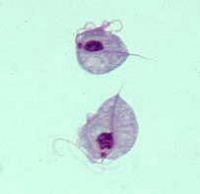| Trichomonas gallinae | |
|---|---|
| Kingdom | Protista |
| Phylum | Protozoa |
| Order | Trichomonadida |
| Family | Trichomonadidae |
| Genus | Trichomonas |
| Species | Trichomonas gallinae |
Introduction
Trichomonas gallinae is the protozoal pathogen responsible for Avian Trichomonosis.
The parasite is identifiable microscopically by its four anterior flagellae and well developed undulating membrane on one side. T. gallinae has no posterior flagellum. Its body is divided by an axostyle.
The ellipsoid nucleus of the parasite is usually found in the posterior aspect of the organism.
T. gallinae requires sugars, starch and glycogen from host cells to survive and replicate.
Transmission
Trichomonas gallinae is present worldwide in wild birds particularly the pigeon and other Columbids.
Transmission between pigeons occurs orally during feeding and mating behaviour.
Transmission to domestic chickens and turkeys is achieved through contaminated water troughs that have been visited by wild birds.
Disease
T. gallinae causes yellow, necrotic lesions and plaques in the gastrointestinal tract of birds, particularly in the crop and oesophagus. Anaemia is caused when the parasite binds to erythrocytes and induces phagocytosis, causing haemolysis. For more information see avian trichomoniasis.
References
Animal Health & Production Compendium, Trichomonas gallinae datasheet, accessed 02/06/2011 @ http://www.cabi.org/ahpc/
| This article has been peer reviewed but is awaiting expert review. If you would like to help with this, please see more information about expert reviewing. |
